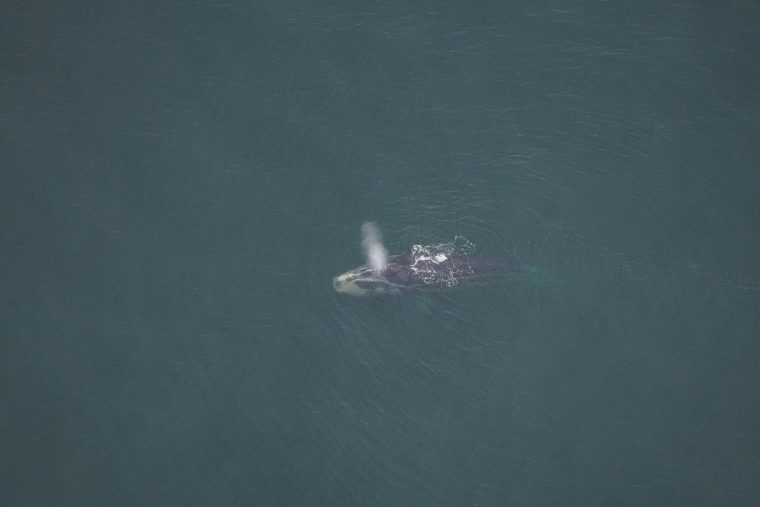Please note: We strongly recommend purchasing tickets online in advance during the heat wave, as our ticket booth is located outdoors.

SYDNEY, AUSTRALIA and BOSTON, MASS. (Oct. 12, 2022) – A new study from researchers at Macquarie University, Ursinus College, and the New England Aquarium has uncovered even fewer North Atlantic right whales are capable of reproducing, a significant finding as the species continues to face threats from human activities including fishing gear entanglements and vessel strikes.
The North Atlantic right whale is one of the most endangered whale species in the world, listed as critically endangered by the International Union for Conservation of Nature (IUCN) with an estimated population of fewer than 350 individuals. Scientists have been raising the alarm about the dwindling number of reproductive females needed to sustain the population. For a new paper published in the journal Frontiers, lead author Joshua Reed, a PhD candidate from the School of Natural Sciences at Macquarie University, used individual female whales’ reproductive history, rather than age, when modelling population trends to provide a better insight into their numbers.
“Our research found that of the estimated 142 female right whales alive in the population at the beginning of 2018, only 72 were actually capable of reproducing. This has certainly influenced the species’ decline in recent years,” said Reed.
The researchers also found that in recent years, young females are less likely to start calving when they reach 10 years of age. Ten was the age at which right whales used to have their first calf in the years up to the turn of the century.
“The evidence that females are not maturing to have calves is very disturbing, and the current trajectory for breeding females is shocking. But there is an important ray of hope in this analysis. If we can eliminate entanglements, then there’s a good chance that the cohort of females who haven’t started calving yet will do so. Then we’d have a baby boom,” said co-author Dr. Peter Corkeron, Senior Scientist at the New England Aquarium’s Anderson Cabot Center for Ocean Life.
Entanglements of North Atlantic right whales typically occur in fixed fishing gear, including lobster and crab pots and gillnets after the whale collides with ropes in the water. The resulting injuries can range from superficial wounds with no attached gear to cases in which the line becomes tightly wrapped multiple times around the whale, resulting in deep wounds, impaired feeding, and energetic costs caused by dragging the heavy gear.
“It is always heart wrenching to consider the slow and painful demise of individual whales, such as Snow Cone, who has been entangled multiple times in fishing gear, including while calving. However, it can be difficult to connect how the loss of an individual, and particularly a breeding female, reverberates through the entire species,” said co-author Dr. Leslie New from Ursinus College. “This work does just that, showing how the continuing loss of reproductively active females, coupled with the inability of other females to even enter the breeding population, has contributed to the species’ decline, and could potentially lead to their extinction within our lifetimes if serious action is not taken.”
Snow Cone (Catalog #3560) has been entangled in heavy fishing gear at least five times. She captured attention in December 2021 when researchers in the right whale calving grounds off the southeastern U.S. sighted her with a newborn calf. Snow Cone was still entangled, with rope deeply embedded in her upper jaw. More than 86% of right whales have experienced at least one and some individuals as many as eight entanglements.
“North Atlantic right whales live in one of the most industrialized habitats of any whale species. Due to the highly urbanized environment, biological and human factors have impacted the survival of the North Atlantic right whale including reduced food availability, vessel strikes, entanglements, and a declining female population,” said Honorary Professor Robert Harcourt from Macquarie University, a co-author of the study.
The researchers noted that the addition of new individuals into the population, through the successful birth and survival of calves, is critical for the continued survival of the species.
“To ensure that the North Atlantic right whale thrives in the future, we need to acknowledge that removing the risk of entanglement, and thus a major source of injury and death, is necessary if enough females are to join the breeding population and successfully reproduce to ensure the species’ persistence,” Reed said.
The New England Aquarium considers ropeless or “on-demand” fishing gear, implemented broadly across fixed-gear fisheries, as the key to a future in which fishing and North Atlantic right whales can coexist. Actively engaged in solutions for more than four decades, the Aquarium has urged the government to develop a strategy to phase in ropeless gear that includes, financial support and subsidies for the fishing industry.
MEDIA CONTACT:
Pam Bechtold Snyder – psnyder@neaq.org, 617-686-5068
